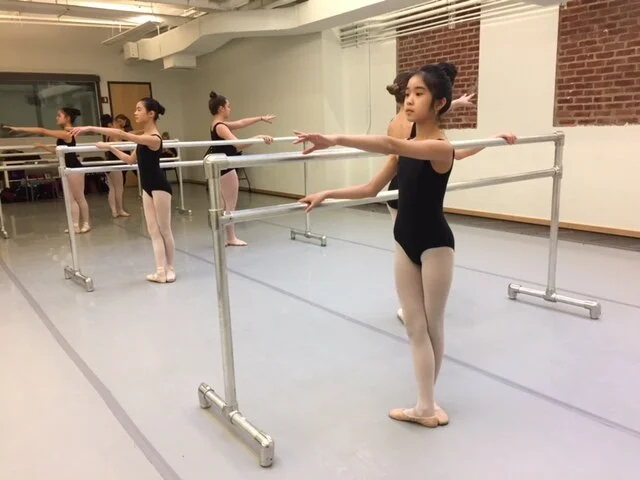Find the perfect fit.
PRE-BALLET: INTRODUCTION TO BALLET (Ages 3-4 years)
Playing games, singing songs, and using props are fun and energizing ways for young children to learn movement basics. The introduction of basic ballet vocabulary provides structure, improves coordination, and challenges the memory. Small classes and one on one attention allow even the youngest dancers to feel comfortable in the classroom environment.
BALLET 1: BEGINNER BALLET (Ages 5-6 years)
Ballet 1 introduces boys and girls to the fundamentals of classical ballet technique. Each class focuses on proper posture, body positions, and alignment while also building on ballet vocabulary. Class structure and discipline are also emphasized, and musicality and creativity are explored through improvisation. Watch your child’s confidence and appreciation for the art form grow as he or she masters new skills and makes new friends.
BALLET 2: INTERMEDIATE BALLET (Ages 7-8 years)
The structure of this traditional ballet class enhances students’ physical and mental discipline while re-affirming posture, placement, flexibility, and strength. Each class begins with barre and centre work, followed by exercises across the floor and reverence. Students learn performance skills and basic music fundamentals while cultivating self-confidence and presence. Students receive the individual attention they need whether they have had previous experience or are absolute beginners.
BALLET 3: ADVANCED INTERMEDIATE BALLET (Ages 9-11 years)
Ballet 3 moves in the direction of a more formal ballet class by adding such classical elements as adagio, petite allegro, pirouettes, grand allegro, and advanced port de bras and epaulement. Emphasizing the importance of form, musicality, and presence makes this class both challenging and rewarding. Ballet 3 may sometimes be found combined with a Ballet 2 or Ballet 4 class. Individual attention is given to students from both levels and class exercises may differ depending on each dancer’s abilities. Previous experience is suggested for this level. While it is not required, Ballet 3 students should consider taking two or more classes per week to gain the proper strength and technical skills necessary to meet their full potential.
BALLET 4: ADVANCED BALLET (Ages 11-13 years)
Building on concepts practiced in Ballet 3, Ballet 4 elevates experienced young dancers into a technically more demanding level that prepares them for pre-professional training. Emphasis is placed on coordination, musicality, and technical proficiency as dancers learn how to execute ballet combinations and choreography both in the center and across the floor. Previous experience is necessary for admittance to this level. While it is not required, Ballet 4 students are encouraged to take class two or three times per week to achieve optimum results in their advancement.
PRE-POINTE/BEGINNING POINTE: INTRODUCTION TO POINTE WORK (Ages 11 years and up)
Students must first be approved by the instructor for admittance to this class. Eligible pre-pointe students must take at least two regular technique classes per week to participate. Pointe shoes are required for those students cleared to begin pointe work. Beginning exercises en pointe will remain at the barre until the student has the proper strength to begin pointe work in the center. Pre-pointe students will take pointe classes on flat until they develop the strength to begin pointe work.
BALLET 5: ADVANCED/PRE-PROFESSIONAL BALLET & POINTE (Ages 14 years and up)
In our most advanced level at CSBA, Ballet 5 moves dancers in the direction of a pre-professional level class. 90 minutes in length, Ballet 5 pushes the advanced student’s stamina and allows for more advanced work across the floor including advanced grand allegro combinations. Most Ballet 5 level students take at least two times per week, as well as work en pointe. Previous experience is necessary for admittance to this level. Students participating in pointe work must take a minimum of two technique classes in addition to their pointe classes. Some technique classes are combined with pointe work for eligible students.







